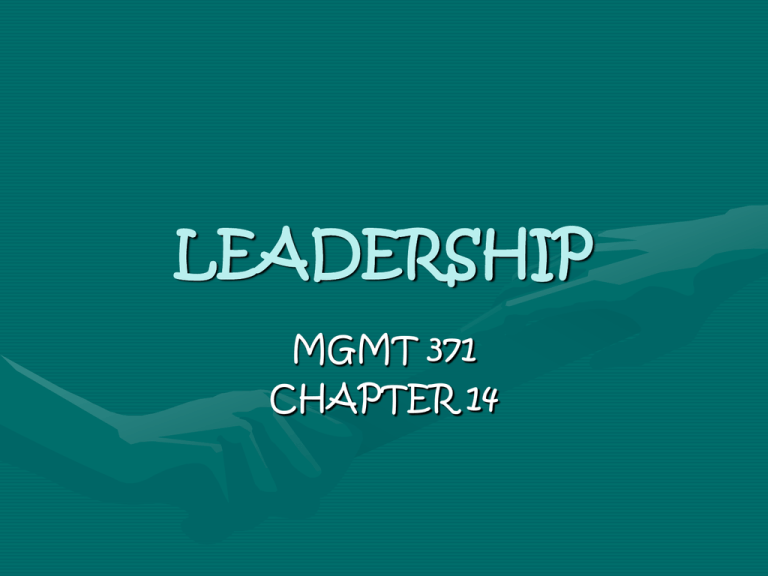
LEADERSHIP
MGMT 371
CHAPTER 14
LEADERSHIP
•
•
•
•
•
•
•
Define
Trait and Behavioral Theories
Situational Theories
Transactional vs. Transformational
Contemporary models
Leaders on leadership
Million dollar questions
Trait and Behavioral
Perspectives
• Trait Theory
– Leadership prototypes
– Gender research
• Behavioral Styles Theory
–
–
–
–
Ohio State Studies
Michigan Studies
Leadership Grid
Implications
Behavioral Styles Theory
• The Ohio State Studies: identified two
critical dimensions of leader behavior.
– Consideration: creating mutual respect
and trust with followers.
– Initiating structure: organizing and
defining what group members should be
doing.
McGraw-Hill
McGraw-Hill/Irwin
© 2005 The McGraw-Hill Companies, Inc. All rights reserved.
Behavioral Styles Theory (Cont.)
• University of Michigan Studies
– identified two leadership styles—employeecentered and job-centered--similar to the Ohio
State studies
• The Leadership Grid
©
– Five leadership styles—combinations of concern
for production and concern for people
•
•
•
•
•
Impoverished management
Country club management
Authority-compliance
Middle-of-the-road management
Team management
McGraw-Hill
McGraw-Hill/Irwin
© 2005 The McGraw-Hill Companies, Inc. All rights reserved.
Situational Theories
• Situational theories: Leader styles
should match the situation
• Fiedler’s Contingency Model
– The performance of a leader depends
on two interrelated factors:
• Degree the situation gives the leader control
and influence
• Leader’s motivation
McGraw-Hill
McGraw-Hill/Irwin
© 2005 The McGraw-Hill Companies, Inc. All rights reserved.
Representation of Fiedler’s Contingency
Model
Situational
Control
High Control
Situations
Moderate
Control Situations
Low Control
Situations
Leader-member Good
relations
Good
Good
Good
Poor
Poor
Poor
Poor
Task Structure
High
High
Low
Low
High
High
Low
Low
Position Power
Strong Weak Strong
Weak
Strong Weak
Strong
Weak
I
IV
V
VII
Situation
Optimal
Leadership
Style
II
III
Task Motivated
Leadership
McGraw-Hill/Irwin
McGraw-Hill
VI
Relationship
Motivated
Leadership
VIII
Task Motivated
Leadership
.
Situational
Leadership Model
Leader Behavior
Relationship Behavior
(supportive behavior)
High
Low
Low
High
R4
Participating
S3
Share ideas and
facilitate in
decision making
Selling
S2
Explain decisions and
provide opportunity for
clarification
Delegating
S4
Turn over
responsibility for
decisions and
implementation
Telling
S1
Provide specific
instructions and closely
supervise performance
Task Behavior
Follower Readiness
Moderate
R3
R2
Follower-Directed
McGraw-Hill
McGraw-Hill/Irwin
High
Low
R1
Leader-Directed
© 2005 The McGraw-Hill Companies, Inc. All rights reserved.
Categories of Leader Behavior within
the Revised Path-Goal Theory
•
•
•
•
•
•
Path-goal clarifying behaviors
Achievement-oriented behaviors
Work facilitation behaviors
Supportive behaviors
Interaction facilitation behaviors
Group-oriented decision-making
behaviors
• Representation and networking
behaviors
• Value-based behaviors
McGraw-Hill
McGraw-Hill/Irwin
© 2005 The McGraw-Hill Companies, Inc. All rights reserved.
Transactional vs.
Transformational Leadership
• Transactional leadership
• Transformational leadership
–
–
–
–
Individual & org characteristics
Leader behaviors
Effects on followers
Outcomes
• What does it mean?
Contemporary Models
• Leader-Member Exchange Model
– in-group exchange: a partnership characterized by
mutual trust, respect and liking
– out-group exchange: a partnership characterized by
a lack of mutual trust, respect and liking
• Shared leadership
• Servant leadership
• Level 5 leadership
Characteristics of Servant Leadership
Characteristics
Description
Listening
Listening to identify and clarify needs and
desires of a group
Empathy
Empathize with others’ needs and feelings
Healing
Make others whole in the face of failures and
suffering
Awareness
Self-aware of strengths and challenges
Persuasion
Rely more on persuasion than positional
authority when trying to influence others
McGraw-Hill
McGraw-Hill/Irwin
© 2005 The McGraw-Hill Companies, Inc. All rights reserved.
Characteristics of Servant
Leadership (Cont.)
Characteristics
Description
Conceptualization
Servant leaders take the time and effort to
develop broader based conceptual thinking
Vision
Foresee future outcomes related to decisions,
actions
Stewardship
Stewards of their followers
Commitment to
followers’ growth
Building community
Committed to followers’ future
McGraw-Hill
McGraw-Hill/Irwin
Strive to develop a “we” culture
© 2005 The McGraw-Hill Companies, Inc. All rights reserved.
The Level 5 Hierarchy
Level 5: Executive
Level 4: Effective Leader
Level 3: Competent Manager
Level 2: Contributing Team Member
Level 1: Highly Capable Individual
McGraw-Hill
McGraw-Hill/Irwin
© 2005 The McGraw-Hill Companies, Inc. All rights reserved.
Gender and Leadership
• Men tend to display more
task leadership; women
more social leadership
• Women tend to be more
democratic and
participative. Men tend to
be more autocratic and
directive.
• Men and women were
equally assertive
• Study: female executives,
rated 360 degrees, scored
higher on a variety of
effectiveness criteria
McGraw-Hill
McGraw-Hill/Irwin
© 2005 The McGraw-Hill Companies, Inc. All rights reserved.
Leaders on Leadership
• Jack Welch:
– Leaders relentlessly upgrade their team,
using every encounter to evaluate, coach
build confidence.
– Make sure everyone sees the vision, lives
it and breathes it.
– Exude positive energy and optimism.
– Establish trust with candor, transparency
and credit.
Leaders on Leadership
• Jack Welch:
– Have the courage to make unpopular
decisions and gut calls.
– A leader’s job is to have all the questions.
Have undying curiosity.
– Model risk-taking and learning.
– Celebrate employee achievement!
Leaders on Leadership
• Rudy Giuliani:
–
–
–
–
–
–
–
Leaders are made.
Develop and communicate strong beliefs.
Be optimistic.
Be courageous; manage fear.
Be ethical.
Prepare relentlessly.
Surround yourself with great people.
Leaders on Leadership
• Rudy Giuliani:
– Be a good communicator.
– Enjoy people; use humor.
– We mentality: “Come with us.”
Leaders on Leadership: Johnson
& Johnson’s Seven Guiding Principles
1. Leadership development is a key business
strategy
2. Leadership excellence is a definable set of
standards
3. People are responsible for their own
development
4. Leaders are developed primarily on the job
5. People are an asset
6. HR is vital to the success of leadership
development
McGraw-Hill
McGraw-Hill/Irwin
© 2005 The McGraw-Hill Companies, Inc. All rights reserved.
And the Million Dollar
Questions….
•
•
•
•
•
Are leaders born or made?
Can we teach leadership?
Which theory is the best?
What can we learn from Katrina?
When is leadership not needed?




